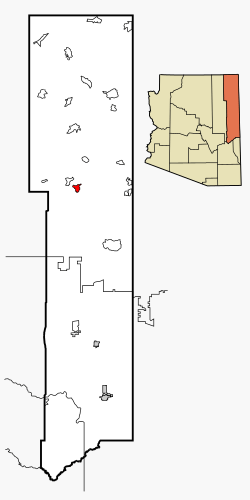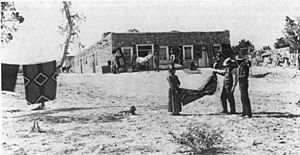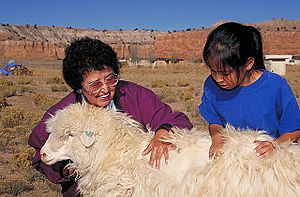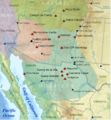Ganado, Arizona facts for kids
Quick facts for kids
Ganado, Arizona
|
|
|---|---|

Location in Apache County and the state of Arizona
|
|
| Country | United States |
| State | Arizona |
| County | Apache |
| Area | |
| • Total | 9.15 sq mi (23.70 km2) |
| • Land | 9.15 sq mi (23.69 km2) |
| • Water | 0.01 sq mi (0.02 km2) |
| Elevation | 6,401 ft (1,951 m) |
| Population
(2020)
|
|
| • Total | 883 |
| • Density | 96.54/sq mi (37.27/km2) |
| Time zone | UTC-7 (MST) |
| • Summer (DST) | UTC-6 (MDT) |
| ZIP codes |
86505, 86540
|
| Area code | 928 |
| FIPS code | 04-26210 |
| GNIS feature ID | 2408273 |
Ganado (Navajo: Lókʼaahnteel) is a special community within the Navajo Nation in Apache County, Arizona, United States. It's known as a census-designated place (CDP), which means it's a community that is counted in the census but isn't officially a city or town. In 2020, about 883 people lived there.
Ganado is an important part of the Navajo Nation government. It's where a delegate, or representative, is chosen for the Navajo Nation Council. This delegate represents several nearby communities. One of the most famous places in Ganado is the Hubbell Trading Post National Historic Site. It's a preserved 19th-century trading post that shows what life was like long ago.
Contents
Exploring Ganado's Location and Weather
Ganado is located in Arizona at coordinates 35.702571 degrees North and -109.553234 degrees West. The area covers about 23.7 square kilometers (about 9.15 square miles) of land. The wider Ganado area includes several smaller communities like Burnside, Cornfields, and Steamboat.
Ganado's Climate: Hot Summers, Cool Winters
Ganado has a semi-arid climate, which means it's generally dry. Summers can be hot, and winters are cool.
| Climate data for Ganado, Arizona, 1991–2020 normals, extremes 1929–2016 | |||||||||||||
|---|---|---|---|---|---|---|---|---|---|---|---|---|---|
| Month | Jan | Feb | Mar | Apr | May | Jun | Jul | Aug | Sep | Oct | Nov | Dec | Year |
| Record high °F (°C) | 65 (18) |
72 (22) |
85 (29) |
90 (32) |
98 (37) |
101 (38) |
101 (38) |
102 (39) |
96 (36) |
92 (33) |
87 (31) |
73 (23) |
102 (39) |
| Mean maximum °F (°C) | 56.6 (13.7) |
61.3 (16.3) |
69.9 (21.1) |
77.1 (25.1) |
85.4 (29.7) |
93.6 (34.2) |
96.1 (35.6) |
93.3 (34.1) |
88.4 (31.3) |
80.4 (26.9) |
68.5 (20.3) |
58.9 (14.9) |
96.5 (35.8) |
| Mean daily maximum °F (°C) | 44.2 (6.8) |
49.2 (9.6) |
57.5 (14.2) |
64.9 (18.3) |
73.6 (23.1) |
85.3 (29.6) |
89.2 (31.8) |
86.5 (30.3) |
80.3 (26.8) |
68.7 (20.4) |
54.9 (12.7) |
44.5 (6.9) |
66.6 (19.2) |
| Daily mean °F (°C) | 31.0 (−0.6) |
34.8 (1.6) |
42.2 (5.7) |
48.1 (8.9) |
56.7 (13.7) |
66.9 (19.4) |
72.6 (22.6) |
71.2 (21.8) |
64.4 (18.0) |
51.7 (10.9) |
39.9 (4.4) |
31.0 (−0.6) |
50.9 (10.5) |
| Mean daily minimum °F (°C) | 17.8 (−7.9) |
20.4 (−6.4) |
27.0 (−2.8) |
31.2 (−0.4) |
39.7 (4.3) |
48.5 (9.2) |
56.0 (13.3) |
55.8 (13.2) |
48.4 (9.1) |
34.7 (1.5) |
24.9 (−3.9) |
17.6 (−8.0) |
35.2 (1.8) |
| Mean minimum °F (°C) | 1.9 (−16.7) |
4.4 (−15.3) |
12.3 (−10.9) |
20.2 (−6.6) |
27.6 (−2.4) |
36.2 (2.3) |
46.9 (8.3) |
49.0 (9.4) |
35.7 (2.1) |
23.0 (−5.0) |
9.8 (−12.3) |
0.2 (−17.7) |
−4.0 (−20.0) |
| Record low °F (°C) | −27 (−33) |
−25 (−32) |
−9 (−23) |
5 (−15) |
15 (−9) |
27 (−3) |
31 (−1) |
35 (2) |
27 (−3) |
11 (−12) |
−16 (−27) |
−20 (−29) |
−27 (−33) |
| Average precipitation inches (mm) | 0.53 (13) |
0.67 (17) |
0.85 (22) |
0.64 (16) |
0.58 (15) |
0.23 (5.8) |
1.21 (31) |
1.75 (44) |
1.19 (30) |
0.93 (24) |
0.78 (20) |
0.77 (20) |
10.13 (257.8) |
| Average snowfall inches (cm) | 3.0 (7.6) |
2.2 (5.6) |
2.4 (6.1) |
0.2 (0.51) |
0.0 (0.0) |
0.0 (0.0) |
0.0 (0.0) |
0.0 (0.0) |
0.0 (0.0) |
0.2 (0.51) |
1.5 (3.8) |
3.3 (8.4) |
12.8 (32.52) |
| Average precipitation days (≥ 0.01 in) | 2.5 | 2.8 | 3.4 | 2.3 | 2.6 | 1.2 | 4.7 | 5.6 | 3.6 | 3.0 | 2.4 | 3.0 | 37.1 |
| Average snowy days (≥ 0.1 in) | 1.5 | 1.1 | 1.1 | 0.2 | 0.0 | 0.0 | 0.0 | 0.0 | 0.0 | 0.1 | 0.7 | 1.2 | 5.9 |
| Source 1: NOAA | |||||||||||||
| Source 2: XMACIS2 (mean maxima/minima, precip/precip days, snow/snow days 1981–2010) | |||||||||||||
People of Ganado: A Look at the Population
| Historical population | |||
|---|---|---|---|
| Census | Pop. | %± | |
| 2000 | 1,505 | — | |
| 2010 | 1,210 | −19.6% | |
| 2020 | 883 | −27.0% | |
| U.S. Decennial Census | |||
In 2000, Ganado had 1,505 people. About 87% of the people were Native American. Around 55% of households spoke the Navajo language at home, while 45% spoke English. Many families in Ganado had children under 18 living with them. The average age in Ganado was 26 years old.
Ganado's Rich History
Ganado has a long and fascinating history, shaped by ancient peoples and later by the Navajo people.
Ancient Times and Legends
The first people in this region were hunters who followed large animals. Later, smaller groups of hunter-gatherers lived here. Around 1800 BCE, people started farming in the area.
The first permanent residents were the "Basketmaker" Ancestral Puebloans. You can still find the remains of their homes in the red clay hills around Ganado. They were skilled farmers. One of their largest ruins in Ganado is Wide Reeds Ruin, built around 1276.
The Ancestral Puebloans had a huge network of villages and trading routes. Pottery found in Ganado shows trade with distant places, even as far south as Mexico. A large Puebloan center near Ganado was Canyon de Chelly, about 30 miles north. A big drought between 1276 and 1299 led to the end of the Puebloan influence in the Ganado area.
It's believed that the ancestors of today's Ganado community arrived after 1400. The early Navajo people were hunter-gatherers who learned to farm and raise animals. They grew beans, corn, and squash.
The early Ganado Navajo spoke Diné bizaad, which is the 'People's language'. This language is part of the Na-Dené family. It's similar to the Western Apache language. When Spanish explorers arrived in the Southwest, they met these people and called them Apaches de Nabajó.
Jilhéél and Kin Naazinii (Upstanding House)
Stories and archaeology suggest that a famous singer and warrior named Jilhéél came to Ganado in the early 1700s. He is believed to have traveled widely and lived among the Puebloan people. He may have helped build forts in the area, like Kin Naazinii (Upstanding House). This was a fortified Navajo village.
Jilhéél was known for his strength and speed. He could even run down deer! His footprints were said to scare his enemies. He is a well-known figure in Navajo oral history.
Spanish Influence in New Spain
In 1540, the Spanish explorer Francisco Vásquez de Coronado passed near Ganado on his way to the Hopi Villages. Later, King Philip II of Spain wanted to set up missions in Nuevo México. By 1629, a mission was built at Awátobi, a Hopi village.
Spanish travelers used routes through the Ganado area. However, the Pueblo Revolt in 1680 led to the destruction of the mission. A severe drought from 1778 to 1780 also impacted the region. The Spanish eventually left the Ganado area before the Americans arrived.
Navajo and Hopi stories tell how some people escaped and joined the Navajos, creating new clans.
The American Invasion and Ganado Mucho
The Ganado area remained mostly independent until 1849. The Navajo people fought against Spanish, Mexican, and American invaders in the Navajo Wars. In 1864, many Navajos were forced to leave their homes in what is known as the Long Walk. They were not allowed to return until 1868.
One Navajo elder described the Long Walk: "If there was room the soldiers put the women and children on the wagons. Some even let them ride behind them on their horses. I have never been able to understand a people who killed you one day and on the next played with your children...?"
By 1869, the United States government had taken control of the Ganado area.
During the Long Walk, a famous Navajo leader named Ganado Mucho (1809–1893) and other leaders like Manuelito hid in the Grand Canyon. Ganado Mucho was a careful leader who preferred talking things out. During the fighting from 1859 to 1861, he kept Ganado neutral. This helped protect the Navajo people's livestock from being taken by the U.S. Army.
In 1866, Ganado Mucho surrendered and was sent to the Bosque Redondo reservation. He saw that the reservation was a failure. His son was even murdered there. He spoke out against the terrible conditions. After a treaty in 1868, Ganado Mucho and his community returned to Ganado. He was later made a subchief by General William Tecumseh Sherman. Ganado Mucho lived in Ganado until he died and is buried nearby.
The Hubbell Trading Post
The first American trading posts in Ganado started around 1871. These posts helped the Navajo people get goods they couldn't find locally.
Don Lorenzo Hubbell (1853–1930) moved to the area in 1876. Two years later, he bought a trading post that was built in 1874. Legend says Hubbell changed the name of the settlement to Ganado. He did this to honor Ganado Mucho, who signed the Navajo peace treaty of 1868.
Hubbell was born to an Anglo father and Spanish mother. He was 23 when he came to Ganado. He and his wife, Lina Rubi, had four children. Their home became famous and hosted important guests like Theodore Roosevelt.
Hubbell died in 1930, and his son Roman took over the trading post. Roman and his wife built a stone Hogan (a traditional Navajo home) in memory of Lorenzo. The National Park Service bought the trading post in 1967. Lorenzo Hubbell, his wife, and some of his children are buried on a hill near the post. Many Horses, Ganado Mucho's son, is also buried there.
Hubbell helped the local Navajo people by encouraging their weaving and textile market. Other trading posts also operated in Ganado. The Presbyterian Church started a mission, school, and hospital in Ganado in 1901.
Boarding Schools and Cultural Changes
In the late 1800s and early 1900s, many Navajo children from Ganado were sent to boarding schools. These schools were often far from their families. The goal was to change their Navajo identity and way of life. This practice, used in many Indian boarding schools across America, aimed to make Native American children adopt American culture.
Modern Ganado Today
Today, Ganado is one of the most developed communities on the Navajo Nation. Local boards manage farming, and ranches produce organic beef and mutton. The high school basketball teams are well-known. Sage Memorial Hospital serves thousands of Hopi and Navajo patients.
The Hubbell Trading Post hosts an annual art show with art, jewelry, and rug weaving. The Ganado Rodeo Club also holds events. The community is very active, with many Navajo religious ceremonies held in the winter. Ganado's leaders also play a big role in the Navajo Nation Government.
Education in Ganado
Ganado has its own school district, the Ganado Unified School District. This includes Ganado Elementary School, Ganado Middle School, and Ganado High School. The high school has great facilities for sports like football, track and field, swimming, and basketball.
Ganado also has smaller campuses for colleges like Diné College and Northern Arizona University.
The College of Ganado's History
Ganado was once home to the College of Ganado, which started as a nursing school in 1927. The campus was part of the Presbyterian Mission. Some of the old buildings are now used by Sage Memorial Hospital. The nursing school was founded in 1911 and trained about 100 women from many different tribes and countries. Dr. William Worrall Mayo, who founded the Mayo Clinic, even gave lectures there.
Ganado's Art Community
Ganado is famous for its beautiful arts and crafts.

Ganado is known for a special Navajo weaving style called "Ganado Red." Since the early 1900s, these fine rugs and blankets have become world-famous. Lorenzo Hubbell helped to promote this art form at his trading post.
Ganado also has a small group of talented silversmiths. They create beautiful Navajo Jewelry.
Getting Around Ganado: Transportation
The Ganado Airport is a small airport managed by the Navajo Nation. It has a natural dirt runway. There are plans to pave the runway in the future. Currently, there are no control towers or other airport buildings.
Notable People from Ganado
- Brett Helquist, artist
- Cynthia Tse Kimberlin, ethnomusicologist
- Myron Lizer, 10th vice president of the Navajo Nation
- Shelly Lowe, academic administrator
- James S. Wall, Roman Catholic bishop
Images for kids
-
"Vázquez de Coronado Sets Out to the North" (1540) by Frederic Remington, oil on canvas, 1905
See also
 In Spanish: Ganado (Arizona) para niños
In Spanish: Ganado (Arizona) para niños










